Overview
 A decade ago, just one-in-fifty Americans got the news with some regularity from what was then a brand new source the internet. Today, nearly one-in-three regularly get news online.
A decade ago, just one-in-fifty Americans got the news with some regularity from what was then a brand new source the internet. Today, nearly one-in-three regularly get news online.
But the growth of the online news audience has slowed considerably since 2000, particularly among the very young, who are now somewhat less likely to go online for news than are people in their 40s. For the most part, online news has evolved as a supplemental source that is used along with traditional news media outlets. It is valued most for headlines and convenience, not detailed, in-depth reporting.
Broadcast news outlets continue to struggle over the last two years alone, the audiences for nightly network, local TV news and radio news have all slipped. Even so, the recent trends in news consumption are relatively stable when compared to the 1990s when TV news in particular was suffering losses of far greater magnitude.
 Similarly, the latest Pew news consumption survey finds that newspapers, which also have seen their audience decline significantly, are now stemming further losses with the help of their online editions. However, the discrete online-only newspaper audience is quite modest in size.
Similarly, the latest Pew news consumption survey finds that newspapers, which also have seen their audience decline significantly, are now stemming further losses with the help of their online editions. However, the discrete online-only newspaper audience is quite modest in size.
Four-in-ten Americans say they read a newspaper yesterday, with 6% reading a newspaper online 4% read both a print and online newspaper, while 2% read it only online. In addition, 3% say they read something on a local or national newspaper website yesterday. As a result, even the highest estimate of daily newspaper readership 43% for both print and online readers is still well below the number reading a print newspaper on a typical day 10 years ago (50%).
 The biennial news consumption survey by the Pew Research Center for the People & the Press, conducted among 3,204 adults from April 27 to May 22, finds that the audience for online news is fairly broad, but not particularly deep. People who say they logged on for news yesterday spent 32 minutes, on average, getting the news online. That is significantly less than the average number of minutes that newspaper readers, radio news listeners, and TV news viewers spend with those sources. And while nearly half of all Americans (48%) spend at least 30 minutes getting news on television, just 9% spend that long getting news online.
The biennial news consumption survey by the Pew Research Center for the People & the Press, conducted among 3,204 adults from April 27 to May 22, finds that the audience for online news is fairly broad, but not particularly deep. People who say they logged on for news yesterday spent 32 minutes, on average, getting the news online. That is significantly less than the average number of minutes that newspaper readers, radio news listeners, and TV news viewers spend with those sources. And while nearly half of all Americans (48%) spend at least 30 minutes getting news on television, just 9% spend that long getting news online.
The web serves mostly as a supplement to other sources rather than a primary source of news. Those who use the web for news still spend more time getting news from other sources than they do getting news online. In addition, web news consumers emphasize speed and convenience over detail. Of the 23% who got news on the internet yesterday, only a minority visited newspaper websites. Instead, websites that include quick updates of major headlines, such as MSNBC, Yahoo, and CNN, dominate the web-news landscape.
The rise of the internet has also not increased the overall news consumption of the American public. The percentage of Americans who skip the news entirely on a typical day has not declined since the 1990s. Nor are Americans spending any more time with the news than they did a decade ago when their news choices were much more limited. In 1996, people on average spent slightly more than an hour (66 minutes) getting the news from TV, radio or newspapers. Currently, they spend virtually the same amount of time (67 minutes) getting the news from all major news sources, the internet included.
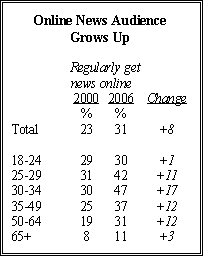 As internet news has gone more mainstream, its audience has aged. Since 2000, nearly all of the growth among regular internet news users has occurred among those ages 25-64. By contrast, virtually the same percentage of 18-24 year-olds say they get news online at least three days a week as did so six years ago (30% now, 29% then). Currently, about as many people ages 50 to 64 regularly get news on the internet as do those in their late teens and early 20s.
As internet news has gone more mainstream, its audience has aged. Since 2000, nearly all of the growth among regular internet news users has occurred among those ages 25-64. By contrast, virtually the same percentage of 18-24 year-olds say they get news online at least three days a week as did so six years ago (30% now, 29% then). Currently, about as many people ages 50 to 64 regularly get news on the internet as do those in their late teens and early 20s.
To some degree, news consumers are drawn to the internet for the very reason that it does not take much time to get news online. Most users say what distinguishes web news is its format and accessibility the ease of navigation, speed with which information can be gathered, and convenience “at my fingertips.” Convenience is a factor for newspapers and television as well, but more readers and viewers refer to the subject matter and journalistic and editorial qualities of the content than is the case among web users.
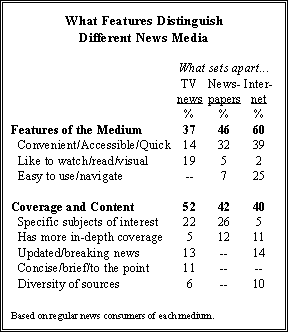 The bottom line for the vast majority of news consumers regardless of news source is that it provides information they need to know each day. A majority of newspaper readers (57%) also say they find the experience “relaxing.” Fewer regular radio news consumers (44%), TV news consumers (41%) and especially internet news users (33%) say they find it relaxing to get the news from those sources.
The bottom line for the vast majority of news consumers regardless of news source is that it provides information they need to know each day. A majority of newspaper readers (57%) also say they find the experience “relaxing.” Fewer regular radio news consumers (44%), TV news consumers (41%) and especially internet news users (33%) say they find it relaxing to get the news from those sources.
The long-standing generation gap in newspaper reading has narrowed over the past decade, in part because of online newspapers, but this is a decidedly mixed blessing for newspapers. It reflects the fact that while newspapers continue to draw anemic numbers of young readers just 29% of those under age 30 that figure has remained stable since 1996, as some young people have turned to online papers. However, newspaper readership among older age groups has fallen significantly over that period. Even when online newspapers are included, 58% of those ages 65 and older say they read a newspaper yesterday, down from 70% a decade ago.
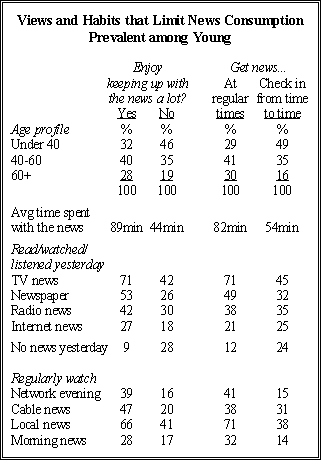 The views and habits that continue to constrain the size of news audiences are shared widely among younger people. Nearly half (46%) of those who do not get a great deal of enjoyment from keeping up with news are under age 40; similarly, 49% of those who check in with the news from time to time, rather than get the news at regular times, are under age 40. These opinions and news habits, which are largely unchanged from past surveys, are strongly associated with less usage of all types of news sources, with an important exception. People who like to check in on the news go online for news about as often as do people who like to read or tune in at set times of the day.
The views and habits that continue to constrain the size of news audiences are shared widely among younger people. Nearly half (46%) of those who do not get a great deal of enjoyment from keeping up with news are under age 40; similarly, 49% of those who check in with the news from time to time, rather than get the news at regular times, are under age 40. These opinions and news habits, which are largely unchanged from past surveys, are strongly associated with less usage of all types of news sources, with an important exception. People who like to check in on the news go online for news about as often as do people who like to read or tune in at set times of the day.
The survey shows that newspaper readers’ tastes and newspapers themselves have evolved considerably over the past two decades. But one constant remains: Local and community news continues to be the biggest draw for newspapers. And as was the case during the mid-1980s, roughly nine-in-ten of those who at least sometimes read a newspaper say they spend a significant amount of time getting the news about their city, town or region.
Yet other subjects in the newspaper also attract interest from sizable numbers of readers. More than three-quarters of newspaper readers (77%) say they spend a lot or some time reading articles about health and medicine, while 63% spend time with articles on technology; neither subject was asked about in 1985. Since that time, news about business, food and diet, and religion have grown more popular with readers; in contrast, fewer say they are spending time getting TV and movie information and schedules, and reading personal advice columns.
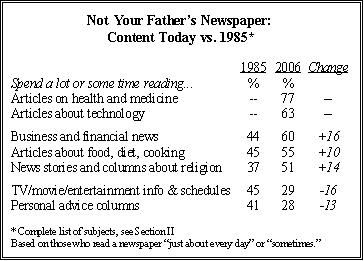 For the most part, the public’s broad news interests have changed little in recent years. But interest in international news and news about the situation in Iraq has declined since the spring of 2004. Currently, a solid majority of Americans (58%) say they follow international news closely only when something important is happening, while 39% say they follow overseas news closely most of the time. In April 2004, a majority of Americans (52%) said they tracked foreign news closely most of the time. (The current survey was conducted before the recent surge of violence in the Middle East and the missile tests conducted by North Korea).
For the most part, the public’s broad news interests have changed little in recent years. But interest in international news and news about the situation in Iraq has declined since the spring of 2004. Currently, a solid majority of Americans (58%) say they follow international news closely only when something important is happening, while 39% say they follow overseas news closely most of the time. In April 2004, a majority of Americans (52%) said they tracked foreign news closely most of the time. (The current survey was conducted before the recent surge of violence in the Middle East and the missile tests conducted by North Korea).
Similarly, public interest in news about Iraq has faded since the spring of 2004, amid the violent uprising in Falluja and the revelation of abuses at the U.S. prison at Abu Ghraib. At that time, 54% said they were following news about the current situation in Iraq very closely. That compares with 43% in the current survey. There also has been a notable decline in the percentage of Republicans following international news most of the time, and the percentage who say they track news about the situation in Iraq very closely. The fall off in interest has been less dramatic among Democrats and independents.
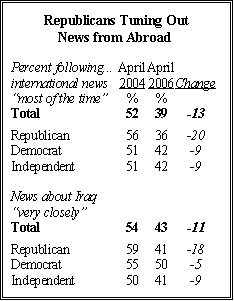 In addition, public interest in national political news is not as great as during the presidential campaign of two years ago. In April, 17% said they follow news about political figures and events in Washington DC, down from 24% two years earlier. In this case, the decline has occurred across the political and ideological spectrum, with one notable exception. About a third of liberal Democrats (34%) say they follow political news from the nation’s capital very closely no change from 2004, and a much higher percentage than in any other political group.
In addition, public interest in national political news is not as great as during the presidential campaign of two years ago. In April, 17% said they follow news about political figures and events in Washington DC, down from 24% two years earlier. In this case, the decline has occurred across the political and ideological spectrum, with one notable exception. About a third of liberal Democrats (34%) say they follow political news from the nation’s capital very closely no change from 2004, and a much higher percentage than in any other political group.
Other Findings
While the growth of internet news has stalled among the very young, a significant number of young people (13%) say they get news via a cell phone, a personal digital assistant such as a PalmPilot or Blackberry, or an iPod or similar portable music player.
The credibility ratings for most major news organizations are either flat or have slipped since 2004. These ratings are highly partisan, though the political differences for most sources have narrowed over the past year as Democrats take a more negative view in the believability of several leading news outlets.
 The percentage of people who say they regularly watch Fox News Channel increased by half between 2000 and 2004 but has stabilized over the past two years. Currently, 23% say they regularly watch Fox News Channel, roughly the same as in 2004 (25%). The network’s audience continues to include a relatively large percentage of Republicans 34% of whom say they regularly watch Fox News Channel, compared with 20% of Democrats.
The percentage of people who say they regularly watch Fox News Channel increased by half between 2000 and 2004 but has stabilized over the past two years. Currently, 23% say they regularly watch Fox News Channel, roughly the same as in 2004 (25%). The network’s audience continues to include a relatively large percentage of Republicans 34% of whom say they regularly watch Fox News Channel, compared with 20% of Democrats.
The percentage of Americans who say they regularly listen to National Public Radio has approximately doubled since 1994 (from 9% to 17%). Nearly twice as many Democrats as Republicans say they regularly listen to NPR (22% vs. 13%). A decade ago, NPR’s audience was fairly evenly balanced politically.
Online newspapers have extended the reach of national newspapers, such as the New York Times, the Washington Post, and USA Today. While more than nine-in-ten readers of print newspapers read local newspapers, only about half of readers of online newspapers do so with many of the rest reading the New York Times and other national newspapers.
The audience for network news morning programs has remained stable in recent years, largely on the strength of women viewers. Fully 64% of those who say they regularly watch these programs are women, while just 36% are men.
Just 4% of Americans say they regularly read online blogs where people discuss news events, but that figure increases to 9% of those ages 18-24. About the same numbers of Republicans, Democrats and independents read news blogs regularly.


